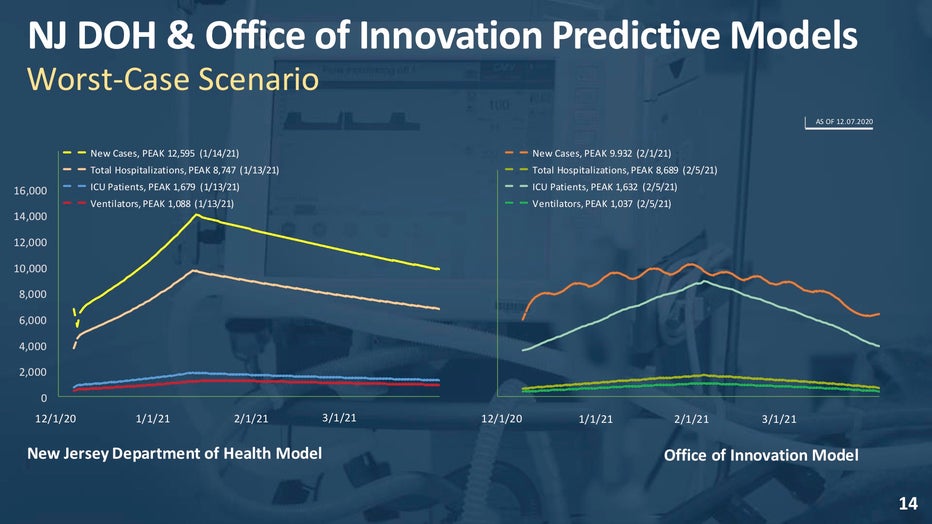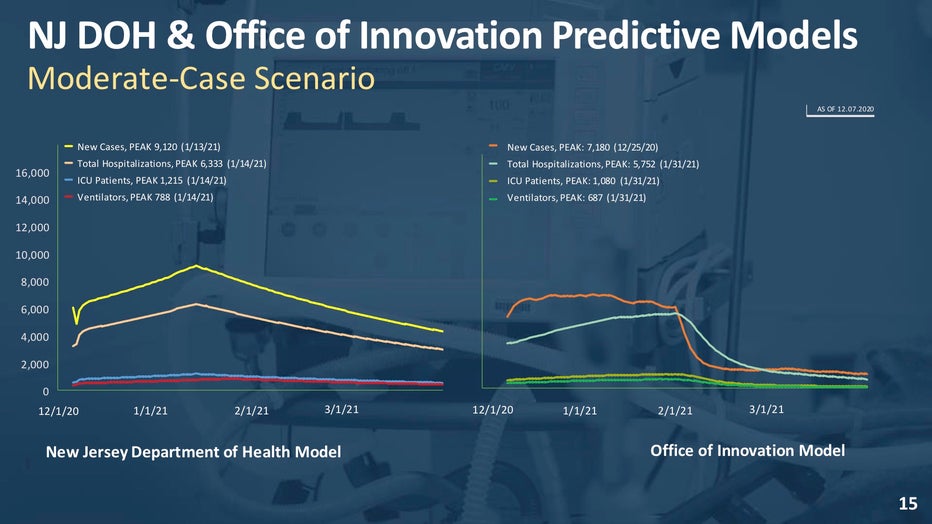New Jersey forecasts the next several weeks of the coronavirus pandemic

New Jersey forecasts the next several weeks of the coronavirus pandemic
Jeff Cole reports on the latest coronavirus models Gov. Phil Murphy put forward Wednesday
TRENTON - New Jersey Gov. Phil Murphy on Wednesday shared new models developed by the Department of Health and Office of Innovation that attempt to forecast the next several weeks of the coronavirus pandemic.
Murphy was rejoined by Department of Health Secretary Judy Persichilli who was in self-isolation following COVID-19 exposure. The governor delayed the announcement of the models last week due to Persichilli's absence.

New Jersey forecasts the next several weeks of the coronavirus pandemic
NJ Gov. Phil Murphy shares newly developed models that forecast state's fight against pandemic.
The Department of Health and the Office of Innovation worked to produce a total of four models to predict the coming weeks of the pandemic. Two models looked at the worst-case scenario where there is no change in current mask compliance, social distancing and gatherings.
Under this grim outlook of the coronavirus pandemic, the Department of Health's model predicts that cases in the state will top 12,500 cases by Jan. 14. The Office of Innovation targets a peak of nearly 10,000 infections on Feb. 1.
Murphy said hospitals are forecasted by both models to reach higher capacity than the springtime. The Department of Health and Office of Innovation both predict a peak of around 8,700 hospitalizations. Murphy said the only "solace" he found in the grim chart is that ICU and ventilator numbers are not overcapacity.

NJ Gov. Phil Murphy shared a grim model of the next several weeks of the coronavirus pandemic on Wednesday.
The second set of models shared a more hopeful outlook where mask-wearing is heightened in the Garden State and a larger emphasis is placed on social distancing and gathering rules.
Under these models, Murphy said hospitals are expected to remain in the state's 'safety zone,' meaning they will not be stretched to the limit or run overcapacity. The peak number of cases as forecasted by health officials is anticipated to reach 9,120 in early January. The Office of Innovation has a more optimistic peak with 7,180 infections.

The moderate-case scenario factors in a greater emphasis being placed on social distancing and mask wearing.
Murphy warned these models are constantly being updated for better or worse with the freshest data. Months-worth of data points have given health experts a better outlook on the pandemic than in the springtime when data was scarce, Murphy said.
The models did not factor in vaccination rates because they will likely be too low to have a significant impact on the overall public during the first few weeks of the new year.
"These models are just that, they're models," Murphy said. "They improve the more we focus on social distancing, the more we wear our masks, the more we use common sense, and the more we can change them for the better the sooner we can crush the curve of the second wave."
___
For the latest local news, sports and weather, download the FOX 29 News app.
DOWNLOAD: FOX 29 NEWS APP
Sign up for emails from FOX 29, including our daily Good Day Digest newsletter

